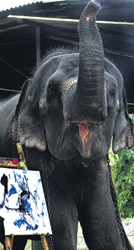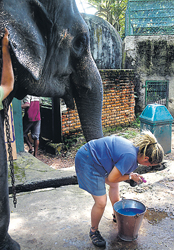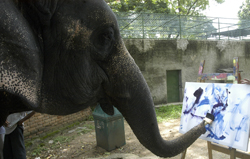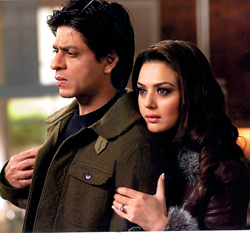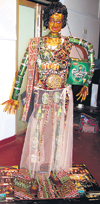|
|
||||||||||||||||||
|
Devi to trumpet her colours again Remember the painting-elephant at the Dehiwela Zoo? Well, she’s working along with her trainer Lori, for an exhibition of her creations
Carrying the Sacred Tooth Relic in peraheras, transporting heavy loads and roaming freely in wildlife sanctuaries, are all sights Sri Lankans especially are familiar with, when it comes to elephants. But painting? A familiar sight at the Dehiwala Zoo for the past week or so is Devi the elephant who is more than adept with her brush and paints. The 23-year-old, friendly elephant willingly takes the paintbrush placed in her trunk and gracefully applies colourful strokes on a canvas. Gently coaxing her to complete each of her paintings is Lori Forster, a Canadian volunteer who works specially with elephants.
“The Exhibition of Paintings by Devi” showcasing all of Devi’s works will be held at the Lionel Wendt Gallery on September 5 and 6, from 10 a.m. to 8 p.m. The proceeds of the sales of the paintings will be in support of the Sri Lankan elephant, and in particular be utilised for the purchase of a much needed GCB bulldozer for the Pinnawela Elelphant Orphanage. The exhibition is sponsored by Paradise Road Galleries.
Explaining how she initially got involved in this type of work, Lori says that elephants have always interested to her. “I started a non-profit organisation called “Elephants in Need” which was mainly for fundraising and to educate people about Sri Lankan elephants and their conservation,” she said. Volunteering at the Pinnawela Elephant Orphanage for three months in 2003, she also received mahout training from a well-respected mahout trainer, Mr. K.G. Sumanabandu. Returning to Canada, she received training from the Edmonton Valley Zoo in teaching elephants to paint. Her forte being Environmental Science, Lori is a Toxic Substance Officer for the Federal Government of Canada. Though a lover of nature, she unfortunately couldn’t go on to become a vet, due to being allergic to most animals, hence elephants are a perfect choice to work with, she says.
Training elephants to paint is something she enjoys doing. “I use a process called positive reinforcement method, which involves no reprimands. It’s basically a mild method, where massaging, eye contact and gentle conversation is used. When the elephant carries out an act successfully, she is given a treat such as sugar cane, fruit or jaggery, as a reward.” Having worked with Devi previously as well, this particular elephant was chosen since Lori heard that she preferred to work with female trainers. The process is useful for the animal as well, Lori says, since it helps their mental stimulation and enhances the use of trunk muscles. Asked whether Devi understands what she is doing, Lori feels that she does. “I initially taught the procedure, a step at a time. I first gave her the brush without paint since she attempted to put it in her mouth, and then I slowly introduced the brush with paint and then showed her how to stroke the canvas with the brush. And then she got comfortable with the process. Of late Devi seems to look straight at the canvas before painting,” she adds. Lori is on the board of directors of the Edmonton Valley Zoo, and also a volunteer there. A Buddhist, she is interested in the connection between elephants and Buddhism.
Courageous exploration of marital life “Khabi Alvida Naa Kehna” (KANK) (Never Say Goodbye), now showing at Liberty Cinema Do you consider marriage a sacred institution? Most people do and that is why films based on marriage are necessarily controversial. If infidelity or marriage breakups are the themes, then they become even more controversial. As one critic said, everyone can see something of his or her marriage in this film and that is why it is scary. “If it could happen to them, it could happen to us,” seems to be the undercurrent and that is probably why the film has sparked such a furore especially among urban middle-class Indians. The film is set amid the expatriate Indian community in New York and the sets are different to the usual Indian scenes. But the lavish costumes and sets with crowd scenes are all there providing colour and spectacle to the story. There is much humour too in the dialogue with the serial child kidnapper “Black Beast” being brought in and a fat child afraid of the beast becoming the target for Dev’s (Shah Rukh Khan) wit. Dev and Maya (Rani Mukherjee) too mistake each other for the kidnapper ending in laughter in the hospital.
The married couples also provide much humour given their situations and there is a delicate and subtle blend of seriousness and humour providing much entertainment. But all the characters are looking for love and happiness just like everyone else and all four characters are humanized making it difficult to point fingers or blame anyone for the breakups. I myself am a strong believer in the sanctity of marriage and went to see the film searching for loopholes as to why the story was wrong. But I could find no fault mainly because the hero and heroine paid for their sins through three years of loneliness, also giving time for their spouses to take them back if they wanted to. But both spouses moved on and that was why the happy ending was possible even though the last line of the film is an apology; “Though we wish that our happiness had not been paved with broken hearts.” This is no doubt a topical theme given that marriages are breaking up and infidelity is a common cause all over the world, not just in India and Sri Lanka. It takes courage to explore such themes and director Johar has enlisted the help of the Hindi film world’s superstars to tell a plausible story. He also points out that marriages should continue to be based on love and nothing less would do for human beings. This is stated by Amitabh Bachchan as the fond father who is himself a womanizer paying the price for infidelity when he talks of “these incomplete relationships” encouraging Maya to leave her husband to whom she is a mother figure. The fact that she cannot have children is another modern theme which is explored because it does not really affect either of her marriages. As usual, Shah Rukh Khan’s acting is superb along with that of Rani Mukherjee and the two spouses, Preity Zinta and Abishek Bachchan. Each plays a larger than life role as is common in Hindi films where the stars act in a world of their own. Although Dev is a football coach, we don’t see him slogging at work. But the dialogue brings out the mismatch with his wife Rhea bringing out a modern theme that she is the “Man in the house” as she brings home the bacon. Dev as the frustrated husband taking it out on the child is well brought out. Throughout, the story is sensitively handled for no doubt the director and cast were aware that they were treading on hallowed ground. This film is different to the usual escapist Hindi film because of the theme although the dance sequences and songs are also there, providing entertainment. When Dev and Maya declare their love, they are seen dancing in forest glades and city sidewalks. The film provides adult entertainment and should be viewed by married couples who are still interested in making their relationship work.
Diverse women with diverse creations and messages
A diverse set of creations presented by The International Women Artists’ Residency 2006 greeted the viewers who entered the Goethe Institute, Colombo 7, from August 22 to 27.
Noeline Fernando, a Sri Lankan member of the International Women Artists’ Residency stood beside her artistic installation made of Carlsberg bottles and cans.
“I love beer. Each individual here has her own theme. My theme is beer and Carlsberg is my favourite beer,” she said cheerfully. She had made up her creation with Carlsberg cans and bottles she had collected at home. “I enjoyed doing this creation. It’s like picking up the things we have thrown away. The main idea I wanted to convey was that we do not drink to get drunk but just for the joy of it.” Sabrina from India portrayed the life of a child in India, or in Asia and called it “Lost in Translation”.
“It’s about how children grow up in a protected family environment and later feel suffocated by that same protectiveness and try their best to break free,” she explained. The Vesak lanterns, cushions, and roots of a tree that have grown out of a cover which encapsulates the whole creation clearly indicate the youth who are struggling to break free from the grip of protection only to realize that they have a bloodline connected to that protective environment.
“The cushions represent my grandfather who gave me all the comforts and the eyes stand for the perception and vision of my grandmother,” she added. Pakistani artist Kaif Ghaznavi stood near a huge pair of scissors which she had made to represent the mind forged manacles people have put on, parallel with their culture. “Most of the women in my country have this mentality that a prince on a white horse will come to marry them. The theme of my creation is to warn against fantasies and cultural taboos that hinder one’s independence,” she explained. |
||||||||||||||||||
Copyright © 2006 Wijeya Newspapers
Ltd. All rights reserved. |
